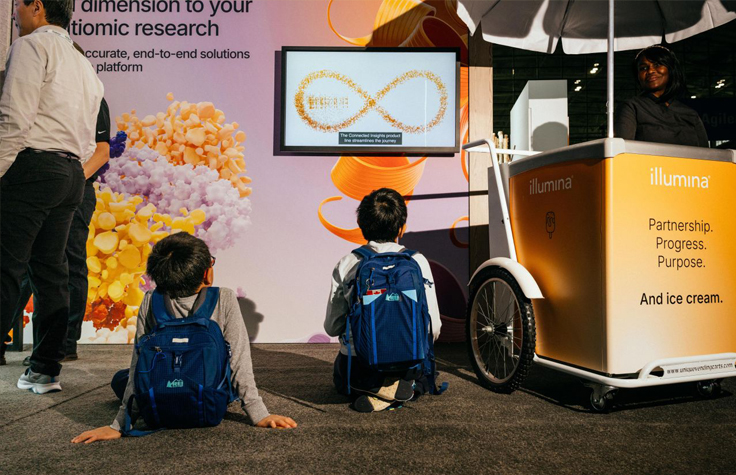
21 October 2025
I’ve just returned from the American Society of Human Genetics Annual Meeting in Boston, where my colleagues and I set the stage to redefine the limits of what’s possible in the next era of multiomics.
At Illumina, we’re establishing a new paradigm, where researchers no longer have to choose between deeper insights and larger scale. And our early-access customers are proving this out with meaningful results. They’re transcending yesterday’s limitations to reveal our first glimpse into new dimensions of actionable insights that will innervate the research ecosystem.
Multiomics is extremely complex. It goes beyond the world of DNA—both coding and noncoding—to divine the distinct functions of RNA, proteins, methylated DNA, and the molecular products of metabolism. There are different modes for scale, for resolution, and for context. But if we hope to gain deeper biological understanding, we must move forward with the best multiomic, multimodal tools possible.
Together with our partners, Illumina has committed to developing the sequencing technologies to pierce the veil into previously unimagined layers of biology. We are executing on the innovation road map we announced last year. These innovations are not part of some far-off wish list—they’re here, and they’re all being leveraged with the NovaSeq X Series.
Last week at ASHG, we launched the Illumina 5-base solution, a truly end-to-end genomic and epigenomic workflow. And at the beginning of next year, we’ll be launching our constellation mapped read technology. Let me tell you why I’m so excited to see these solutions put to use.
Constellation mapped-read technology: Say hello to long-range insight, goodbye to library prep
Library preparation has always been one of the most time-consuming and labor-intensive parts of genome sequencing. But there’s never been an easy way around it—until now.
Constellation mapped read technology from Illumina eliminates the need for all the quantifying, washing, fragmenting, denaturing, and tagging. You simply extract and load the long, unfragmented DNA sample directly to the flow cell. You’re ready to sequence in minutes, not hours. If you’re already working with a NovaSeq X Series platform, all it requires is a software update and a few new reagents. Historically, you had to choose: seeing small variants at scale or tracking complex regions with complicated, time-consuming long-read technologies. Constellation brings them together in a comprehensive, cost-effective workflow.
GeneDx, a Maryland-based genomic research and diagnostics company, piloted constellation with their fleet of NovaSeq X Systems to study 160 DNA samples from people with a known genetic disease and compared those results to samples run on comparable methods. Their early data, highlighted at ASHG, showed that constellation technology was able to accurately identify repeat expansions, complex structural variants, and other challenging genomic regions—demonstrating its potential to meet or exceed the capabilities of other established methods.
Joe Devaney, director of the Laboratory Innovation Team at GeneDx, reports that “the level of detail we can achieve with constellation provides promising insight into some of the world’s most complex and difficult-to-diagnose diseases. By combining speed, simplicity, and scientific rigor, this technology has the potential to transform how we understand rare disease, helping improve how we diagnose and treat patients.”
Illumina 5-base technology: A more complete view of cancer and rare diseases, within reach
Different genes can be expressed or inhibited in response to environmental or developmental factors: One way this happens is when a methyl group is added to cytosine, converting it to methylated cytosine—essentially a “fifth base.” Reading this epigenetic information gives us an additional dimension of data from a given point in time.
Conventional methods for profiling DNA methylation convert unmethylated cytosine to thymine, effectively trading a huge amount of other information in the process.
Illumina’s proprietary 5-base chemistry preserves the full, awesome complexity of the epigenome by instead converting methylated cytosine to thymine. Custom Illumina DRAGEN algorithms can still tell the difference between these converted bases and standard thymine by checking their complements: It expects thymine to be paired with adenine, and the converted bases to be paired with guanine.
The combined power of genetic and epigenetic information generates maximum biological insights in a single sequencing run. Research Chair Bekim Sadikovic, at the London Health Sciences Centre Research Institute, is one of over 50 early testers who are applying this innovation to their multiomic research questions. He says: “This is going to allow us to add layers of insight that go beyond genetics alone, toward a more complete view of rare diseases”; and at the meeting, he added, “We’re really excited about this technology. Having a technique that’s able to capture methylation with sequencing will help us with the unknown genome.”
When the potential of all these omes is taken together, it’s abundantly clear: The datasets made possible by multiomics on top of upgraded WGS technology like 5-base and constellation set a new high bar for diagnosis and pharmaceutical discovery.
At Illumina, we are dedicated to the goal of revealing biology in its full context. We see a future when no part of the fundamental machinery of life remains mysterious. We work hard every day developing reliable tools to help our partners and customers decode the complexity of disease and uncover novel biomarkers, and we are so excited to see what they’ll find next.

Two future scientists enjoy the amenities of the ASHG conference. | Photo by Jayne Chong


